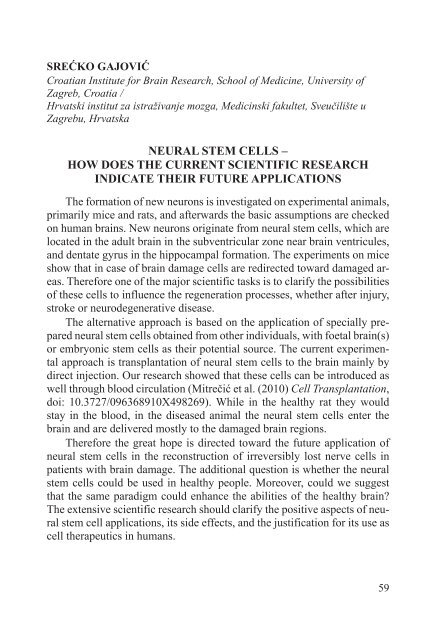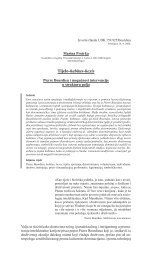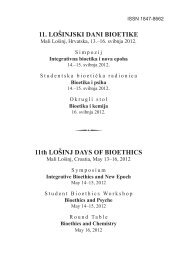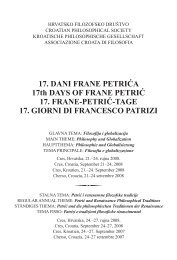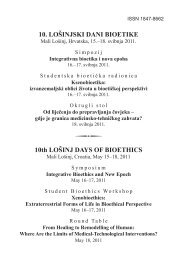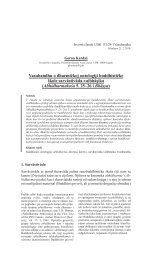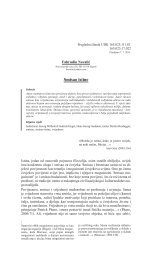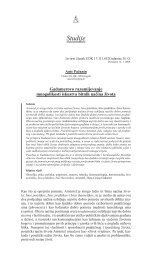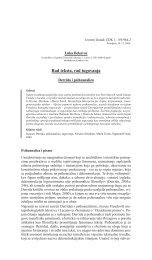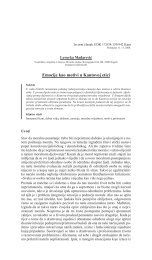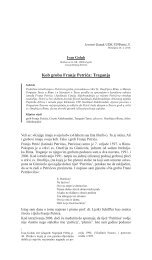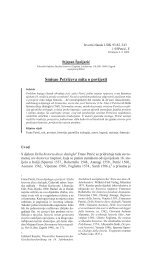Programska knjižnica 9. Lošinjskih dana bioetike - Hrvatsko ...
Programska knjižnica 9. Lošinjskih dana bioetike - Hrvatsko ...
Programska knjižnica 9. Lošinjskih dana bioetike - Hrvatsko ...
Create successful ePaper yourself
Turn your PDF publications into a flip-book with our unique Google optimized e-Paper software.
SREĆKO GAJOVIĆ<br />
Croatian Institute for Brain Research, School of Medicine, University of<br />
Zagreb, Croatia /<br />
Hrvatski institut za istraživanje mozga, Medicinski fakultet, Sveučilište u<br />
Zagrebu, Hrvatska<br />
NEURAL STEM CELLS –<br />
HOW DOES THE CURRENT SCIENTIFIC RESEARCH<br />
INDICATE THEIR FUTURE APPLICATIONS<br />
The formation of new neurons is investigated on experimental animals,<br />
primarily mice and rats, and afterwards the basic assumptions are checked<br />
on human brains. New neurons originate from neural stem cells, which are<br />
located in the adult brain in the subventricular zone near brain ventricules,<br />
and dentate gyrus in the hippocampal formation. The experiments on mice<br />
show that in case of brain damage cells are redirected toward damaged areas.<br />
Therefore one of the major scientific tasks is to clarify the possibilities<br />
of these cells to influence the regeneration processes, whether after injury,<br />
stroke or neurodegenerative disease.<br />
The alternative approach is based on the application of specially prepared<br />
neural stem cells obtained from other individuals, with foetal brain(s)<br />
or embryonic stem cells as their potential source. The current experimental<br />
approach is transplantation of neural stem cells to the brain mainly by<br />
direct injection. Our research showed that these cells can be introduced as<br />
well through blood circulation (Mitrečić et al. (2010) Cell Transplantation,<br />
doi: 10.3727/096368910X498269). While in the healthy rat they would<br />
stay in the blood, in the diseased animal the neural stem cells enter the<br />
brain and are delivered mostly to the damaged brain regions.<br />
Therefore the great hope is directed toward the future application of<br />
neural stem cells in the reconstruction of irreversibly lost nerve cells in<br />
patients with brain damage. The additional question is whether the neural<br />
stem cells could be used in healthy people. Moreover, could we suggest<br />
that the same paradigm could enhance the abilities of the healthy brain?<br />
The extensive scientific research should clarify the positive aspects of neural<br />
stem cell applications, its side effects, and the justification for its use as<br />
cell therapeutics in humans.<br />
59


